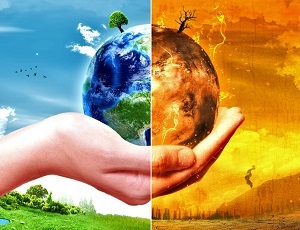
14 December marked the end of the COP24 climate summit hosted in Katowice, Poland, one of the most important global events organised this year. We asked Dr hab. Agnieszka Wypych from the JU Faculty of Geography and Geology Department of Climatology to tell us more about the climate changes that are happening right before our very eyes and what’s in store for us in the future.
The ubiquitous changes in climate we currently observe are one of the most important scientific, social, and economic challenges humanity has ever faced. A vast number of expert teams, local and national governments, non-government organisations, and environmental activist groups unanimously deem this issue to be a crucial one, calling for pollution mitigation and climate change adaptation in order to achieve sustainable development.
Climate variability is a set of innate natural processes that affect the atmosphere. Instrumental temperature records dating back as far as the 1800s as well as climate reconstructions of earlier periods of time based on various indirect factors clearly show that there have been some major swings in the Earth’s climate. However, these swings happened over long intervals of time (at most, 1/10°C per century). They were caused by fluctuations in solar radiation, Milankovitch cycles, and, to a lesser extent, volcanism. Human activity has greatly sped up these processes, resulting in a 1.1°C increase in global temperature since the beginning of the 20th century (and even 2°C in heavily urbanised areas).
This issue, known as global warming, is the subject of an animated public debate, with scientists, economists, and politicians making varying and often contradictory claims about it, and the media often only blurring the image instead of clarifying it. The one undisputable fact is that the global rise in air temperature will lead to further consequences. Climate consists of a series of interconnected processes directly tied to the environment in which they occur. Increase in temperature (brought about by radiative forcing) means an increase in energy in the atmosphere, causing an escalation of extreme weather. It also affects the water cycle, leading to even more problems. If this trend continues for the next several decades, the changes could reach catastrophic proportions (polar ice cap melting, sea level rise, climate zone change, and so on).
 It’s unsurprising that restoring the balance of climate is the aim of many organisations and institutions. We’ve only just started limiting our impact on global climate several dozen years ago, when we first observed ozone depletion and greenhouse effect intensification caused by an excess of greenhouse gases in the atmosphere (mostly carbon dioxide). In 1988, the Intergovernmental Panel on Climate Change was established within the framework of the United Nations Environment Programme. Every several years, it compiles a report on climate changes and their possible consequences. There are also other numerous international initiatives that focus on reducing man-made climate changes.
It’s unsurprising that restoring the balance of climate is the aim of many organisations and institutions. We’ve only just started limiting our impact on global climate several dozen years ago, when we first observed ozone depletion and greenhouse effect intensification caused by an excess of greenhouse gases in the atmosphere (mostly carbon dioxide). In 1988, the Intergovernmental Panel on Climate Change was established within the framework of the United Nations Environment Programme. Every several years, it compiles a report on climate changes and their possible consequences. There are also other numerous international initiatives that focus on reducing man-made climate changes.
The first United Nations Framework Convention on Climate Change – the Rio de Janerio Earth Summit – was organised in 1992. The next big developments came in the form of the 1997 Kyoto Protocol (which introduced restrictions on greenhouse gas emissions; it was updated in 2012 during the COP18) and the 2015 Paris Agreement. The latter one proposed measures that would reduce global warming to the level of 2°C (compared to the pre-industrial age) by 2100; nevertheless, we should do everything in our power to further limit this to 1.5°C. The conference held in Katowice was devoted to working out a detailed plan to bring the Paris Agreement resolutions to life. The latest IPCC Special Report issued on 15 October 2018 describes the consequences of 1.5°C global warming related to different greenhouse gas emission scenarios.
The report predicts that it will be possible to attain the goal of 1.5°C by 2040. Unfortunately, as the world’s largest economies refused to accept the decisions made at the COP24, some people are beginning to question if smaller countries will even make a difference. Is this question valid? It’s difficult to tell, as there are several arguments both for and against it. But to put it simply: everything we do to protect the atmosphere, we experience first-hand in our local environment.
Original text: www.nauka.uj.edu.pl





